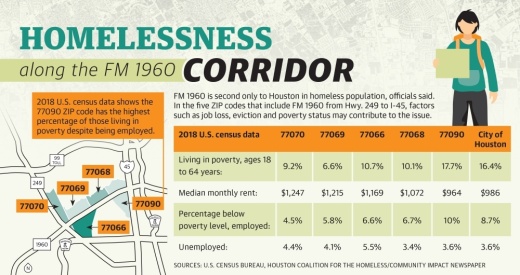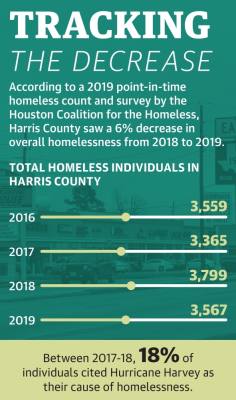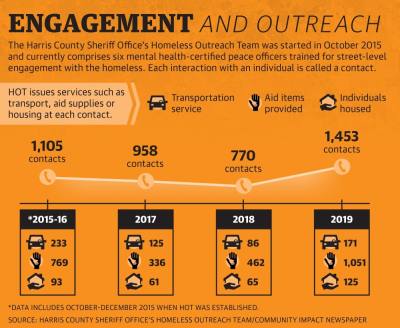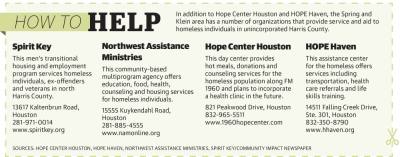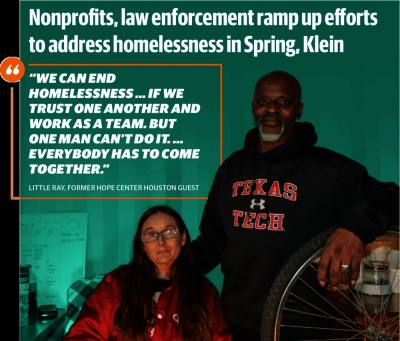Today, Ray and his wife, Brenda, are residents of Greenspoint and operate their business, Flight 23, out of a storage container behind Hope Center Houston. In January, they opened a second location along FM 1960 where Ray said he plans to begin installing motors on the bikes.
“My business is basically to inspire people that if I can do it, they can,” Ray said.
Ray is just one of hundreds of individuals in the Spring and Klein community who have found help through Hope Center Houston, a homeless day center located along the corridor. As the demand for aid to address the issue increases, local nonprofits and law enforcement agencies are working to offer new services and strategies to quash homelessness along the FM 1960 corridor.
Hope Center Houston was able to move to a larger facility in November, allowing it to expand the services it provides, and the organization now has plans to include in-house medical and dental clinics. Additionally, another local nonprofit, Helping Others Pursue Excellence Haven, began fundraising earlier this year for a transitional living community and hopes to provide services in the next three months.
HOMELESSNESS IN THE SUBURBS
A 2019 Homeless Count and Survey, led by the Houston Coalition for the Homeless, found that Harris County experienced a 6% decrease in overall homelessness from 2018 to 2019. Despite the decrease, officials said they believe homelessness in unincorporated areas continues to become more visible.
According to Deputy Gregory Temple of the Homeless Outreach Team, a specialized program under the Harris County Sheriff’s Office, county buses serve as a main mode of transportation for relocating the homeless, as many organizations give bus passes as aid. Along FM 1960, the Metropolitan Transit Authority of Harris County’s bus line services five routes and more than 40 bus stops between Hwy. 249 and I-45.
Temple said, like many Harris County residents, homeless individuals choose to live in the safer, unincorporated areas of the county to escape the dangers of living in a crowded city—despite having less access to Houston’s plethora of social services.
“[The homeless] would rather be somewhere [where] not as many people [are] homeless. ... Here, they’re more spaced out,” Temple said.
However, according to Ana Rausch, the vice president of operations at the Houston Coalition for the Homeless, not all homeless individuals in unincorporated Harris County migrated from Houston.
“There’s a misconception that homelessness is rising and going out into the county,” Rausch said. “Homelessness is just more visible now because we have so much new development and construction.”
In 2019, HOT made 1,453 contacts with the homeless population, meaning officers met with a homeless individual and provided transportation, referrals or aid supply services—almost double the number of contacts they made in 2018. HOT attributes the increase to four more deputies being added to the team over that time.
According to the Houston Coalition for the Homeless, many factors can contribute to homelessness, such as job loss, eviction or mental illness. Additionally, Temple said major catastrophes such as Hurricane Harvey and Tropical Storm Imelda can exacerbate homelessness, as shelters often fill up with families, leaving individuals on the street.
Temple said he believes most people are only one traumatic event away from finding themselves in a crisis situation.
“[Homelessness] has no boundaries,” Temple said. “It reaches black, white, Hispanic, male, female, children. It has no set face but ... has many colors.”
A DAILY STRUGGLE
To keep up with the increased demand for services from the area’s homeless population, nonprofits such as Hope Center Houston expanded in physical space and resources. Formerly known as 1960 Hope Center, the nonprofit relocated from a 3,000-square-foot building to a 14,000-square-foot facility in November.
“Our [daily] population has doubled in the last six months,” Executive Director Bob Butler said. “Maybe it’s because we’ve moved to another location, but we were seeing 30-35 [guests] a day. We’re now at 55 or 60.”
While still located along the FM 1960 corridor—the epicenter of the area’s homeless population—Butler said the new facility off Red Oak Drive allows for more on-site mentors, caseworkers and social workers. During the week, the center offers access to showers, two hot meals per day and clothing in addition to counseling, mail and photo ID services.
“As the [homeless] population grows, this situation gets worse,” Hope Center Houston founder Debbie Johnson said. “We’ve got this nice, big building, and [Butler] said the other day, ‘We may be outgrowing this building,’ and I could see [how] that would happen.”
Butler said the new building’s mortgage is expected to be at least five times the original building’s monthly $1,500 rent. Hope Center Houston also plans to add a medical and dental health clinic over the next year and a half—both of which are costly projects to launch at an estimated $100,000 and $25,000, respectively.
Most of the center’s funding comes from individual and church donations; however, Butler said pursuing government-level grants would be critical for the organization’s growth.
“There’s a lot of competition for grants, and most organizations have employed grant writers,” Butler said. “We haven’t taken that step yet. ... For every grant that’s out there, there’s dozens ... of organizations trying to get it.”
Additionally, Hope Center Houston’s new facility now houses HOT offices and serves as the team’s center for operations, making it easier for officers to refer individuals to the center’s services. HOT started as a team of two mental health-certified peace officers assigned to unincorporated Harris County in October 2015. Today, the team is up to six members with plans of adding four more officers by the end of this year.
“We have great success stories where we’ve helped people ... get into rehab, reunite them with their families,” Temple said. “If we expand our team, we can get people off [the street] in other areas as well.”
SUSTAINABLE SOLUTIONS
Other local nonprofits, such as HOPE Haven, are also focusing on implementing preventive measures to homelessness as long-term solutions.
HOPE Haven Executive Director Krystin Stillwell said she believes the most effective way to assist homeless populations is to sustainably transition them out of their crisis situations. Beginning with community outreach, Stillwell said HOPE Haven aims to pinpoint the source of a client’s crisis and then provide resources and transitional programs catered to each individual.
“We help them fix the barriers that got them stuck,” Stillwell said.
In a public-private partnership with custom homebuilders Mainstreet America, HOPE Haven plans to purchase a 12-acre property near I-45 for Transformation Station, a transitional living community for people struggling with or on the verge of homelessness.
HOPE Haven began fundraising this past summer to raise the $27.3 million needed to fund the project. To date, the organization has raised $3 million in verbal commitments and is now awaiting county-level approval for an $11.3 million grant. Stillwell said HOPE Haven hopes to begin servicing clients in Transformation Station by the end of April.
“At the point that we acquire [the property], we’ll then start [staffing], then start the services,” she said. “I would hope that that would be just in the next few months that we could ... acquire the property and then continue the fundraising.”
According to Stillwell, large-scale funding is difficult for smaller nonprofits, such as HOPE Haven, because it is often awarded to larger, more established organizations. Rooted in this lack of funding is a misconception that homelessness is not an issue in unincorporated areas of Harris County, she said.
“When you look at the county as a whole, there’s this idea that, ‘That’s the wealthy side of town. They don’t need it.’ But we do have homeless out here that need help,” Stillwell said. “You have a lot of organizations that are out here trying to address the need, but yet, the answer to the need is downtown or down south.”




